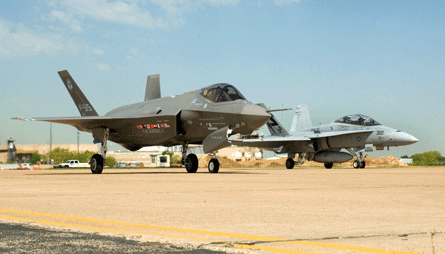Streamlined flight testing, coalition buys and an integrated global supply chain for production and sutainment are among initiatives being pursued to keep the Joint Strike Fighter programme on budget and on track as it reaches the mid-point of development.
Two fewer flight-test aircraft and greater reliance on integration laboratories and flying testbeds is being proposed to reduce costs and restore reserves within the budget to handle unforeseen problems later in the development programme.
The changes are the result of a "mid-course review" half way through the 12-year development programme. "Our ability to define a verification plan is much greater than it was six years ago," says Dan Crowley, Lockheed Martin executive vice-president and F-35 programme general manager. "We are accountable for managing the resources responsibly if we can see a better way to finish the programme."
The plan to reduce the flight-test fleet from 18 to 16 by removing two mission-systems development aircraft has been cleared by the services and is awaiting approval by undersecretary of defence for acquisitions John Young.

The F-35 is being developed in three variants, but the mission system is 98% common. "We are holding to the original value proposition of developing three aircraft for the price of two," says Crowley. "But testing on one variant reduces risk on the others. We do not need three times the flight test and ground test."
Critical design reviews on all three variants have been accomplished, an aggregate 84% of drawings released, and "mission decomposition" completed. "There is a convergence of insight on the air system," says Crowley. "We know a lot more than six years ago, when there was a lot of legacy 'belt and suspenders' thinking on the number of test aircraft."
The programme also needs to replenish the management reserve, which should average 10% of the budget over time but has been eroded by weight, assembly and other challenges. "Even if the reserve was healthy, it would still be the right way to spend the remaining money - by not building aircraft we do not need," he says.
Lockheed's plan is to shift more mission-system testing to the Cooperative Avionics Testbed, or CATBird, a Boeing 737-300 modified to test the F-35's sensors and avionics. The aircraft is in final installation and is due to begin flight-testing of the communication/navigation/identification and electronic warfare systems by year-end.
The "unprecedented collocation, co-ordination and capacity" of the integration laboratories at Fort Worth will avoid the problems that beset flight testing of the Lockheed F-22, Crowley says. The F-22 lacked the laboratory infrastructure, he says, and had hardware and software issues the hobbled flight testing.
"We need lots of flight-test assets for flight sciences, because of the differences between the variants and their flight profiles," he says. "But the laboratories bring a big payoff in less reliance on mission system flight testing to demonstrate maturity." The JSF laboratories are also discovering problems earlier. "Flight testing is the last and most expensive way to find and retire risk," he says.
Talks on a coalition buy modelled on the original European-US commitment for almost 700 F-16s has begun with the JSF partners. Lightning Strike would combine US and international purchases planned for the seven years from 2012 to 2018 into a fixed-price coalition buy potentially totaling more than 1,300 aircraft.
The economies of a coalition buy would avoid the disincentive to purchase aircraft early, he says, but would require the US government to commit to multi-year procurement in 2012. This is two years earlier than planned and before the F-35 has completed operational testing. "The F-16 found a way, and it worked," he says.
Lockheed has also begun planning an integrated global supply chain for production and sustainment. "Lockheed Martin, Northrop Grumman and BAE Systems will only facilitise for 60% of the peak rate," says Crowley. Citing the tight manufacturing tolerances required, he says: "We need to get suppliers started sooner because it will take them longer." A kick-off meeting with major suppliers in planned for year-end.
Crowley says the F-35 programme is "lead turning", preparing proactively for future phases while working to stay within budget. "We need to manage within the resources we are given, and not spend time justifying cost growth. We are trying to live within the resources we have," he says. "We will not degrade the delivered essential warfighting capability. And if we need to fly longer we will."
Source: Flight International
















